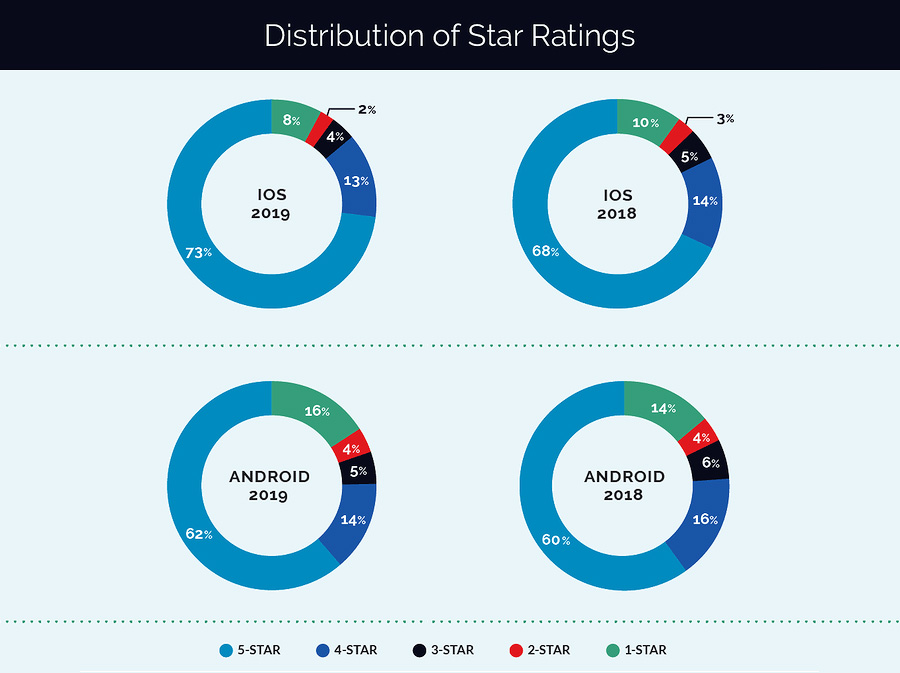Oct 20, 2020 App Development
2020’s Mobile App Rating and Review Milestones
Oct 20, 2020 App Development

Oct 20, 2020 App Development / Neha Joshi
You must be wondering whether reviews really matter for an app?
Without any further ado, let’s jump straight to the conclusion and say “Yes”, it does matter.
Although consumers are turning more sceptical about the digital marketing arena, peer recommendations in the disguise of store app reviews and ratings stand alone as the significant factor of discovery and conversion.
All thanks to GDPR and CCPA, consumer privacy has swapped to the forefront of marketing and app development, and a reliable recommendation in the form of ratings and reviews holds the lion share than ever before.
Established on the data from Apptentive’s 2020 mobile App Engagement Benchmark Report, it’s crystal clear that reviews and recommendations are not just vanity metrics, they have an everlasting impact on brands reputation and conversion rates. Moreover, when asked, consumers were clear that lower the star ratings, the less likely they’d be to download the app. The potential of a star is huge, for instance, moving a three star app to four star can eventually lead to 89% higher conversion rate.
In simple words, reviews play an unskippable role in people’s purchasing power, whether the opinions are about restaurant, movies or app development services.
With respect to the increasing number of apps, unfortunately, people are not in the queue to review your app, even if they fall in love with it. Users are not willing to go back to the app store on their own accord to write a review, but they will surely do that with a soft jab in the right direction.
Continue reading to ace the hidden milestone of reviews and recommendations for app across distinctive platforms.
Mobile apps on Apple app store and Google play store witnessed the drastic changes to their entire distribution of star ratings. From the year 2018 to 2019, Apple apps observed a decline of 20 per cent in one-star ratings and 7% upsurge for five-star ratings. For the same period, Android apps witnessed an upthrust of 14% in one-star ratings and unsurprisingly another increase of 3% in their five-star ratings.

Finally, data speaks it all. The rating and reviews continue to play a significant role in app development growth after a long time, consumers have paved their way to your app store product page, respectively. They can be considered as social proof to draw attention to your app’s quality in the surrounding of the blind evaluation process.
Presently, in both app stores – Google play store and Apple app store, reviews and ratings recently matter more than ever before, which solely means being able to identify and activate your user base.
The conventional rating notification can drive desired results for your app. Still, like most of the things, there is no one-size-fits-all solution offered by mobile app development company for your project’s unique needs. So, to truly understand your clients, all you require is qualitative data to make the quantitative data worth the value, which is next to impossible without gauging sentiments directly through customer feedback.
Voluminous iOS app reviews increased by 35% in 2019, compared to 2018. Whereas the median volume increase of iOS apps was 31%. On the contrary, Android apps witnessed a heavy increase in the volume of reviews with 52% in the same timeline. Undeniable to say, the median volume increase for Android apps was exponentially at 110%.
Generally, there have always been more reviews for Android in comparison to iOS. And, this difference is mostly because of demographics of their customer bases. Android users tend to be younger and much more probable to feel inculcated in the process. Because of this, they are also conventionally more crucial.
But, after the launch of iOS11, it’s evidently observed there is a downturn in the number of iOS reviews because of the streamlined and easy rating process. Just, because of how streamlined the review and rating process is made, leaving reviews and feedback on iOS is a fun thing to do, but mostly users get a feel of “done” with the process just after providing a star in the rating section, with fewer reviews.
In Android apps, users are made to leave the app to complete a rating and review checkup, which makes them feel like more is needed of them to accomplish this task. While in iOS apps, the experience is not hindered, and the user is not driven to some other page, which makes them feel like a simple star rating is enough to complete their input responsibilities.
Although the average volume of star ratings saw similar trends in recent years, the volume of star ratings in iOS apps witnessed a strategic 158% from 2018 to 2019, whereas, the median volume of star ratings for iOS app star ratings upheld to 260%.
The volume of star ratings for Android app increased from 44% from 2018 to 2019. The median volume of Android app star ratings increased to 108%.
Because of the aforementioned data based on absolute averages rather than number of reviews in the year, it’s probably that the app development services in 2019 were impacted by the following:
So, here I am sharing 4 proven ways to increase mobile app reviews and ratings:
Keep in mind never purchase fake reviews, or you will be in the risk of having your app suspended from the app store. Anyhow, organic reviews are a win-win situation for the users, developers and app development company. And, not to forget Alcax’s dedicated team helps to improve the app for their users, as well as maximize its ranking and downloads too.
So, to know how to escalate mobile app reviews, reach to experts and scrape in those good ratings!